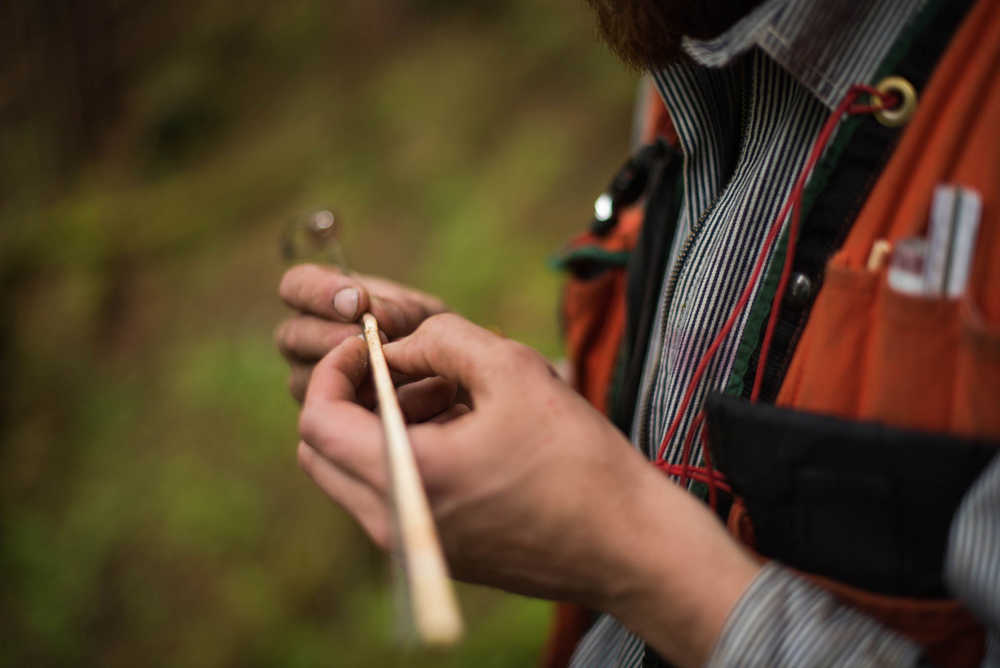Southeast Alaskans are not shy around the forest. Our rural communities are surrounded by the largest remaining temperate rainforest on earth. We build homes and businesses with the natural resources those lands provide. Every summer, Alaskans are reminded that the majority of the fish that feed our world-renowned salmon industry begin their lives among these trees. We escape into the forest and disappear between the spruce and hemlock in pursuit of Sitka black-tailed deer or wild mushrooms. We are forest people, and a coalition of land managers across the region are collaborating to ensure that the people who help manage these forests are the same people who call these lands their backyard.
Harrison Voegeli is one such man. “Seeing that locals are out in the forest hunting — they are the ones out in the forest cutting their firewood and getting trees for their totems — it’s very important to have the participation of locals,” Voegeli said.
Voegeli is one of ten people who are spending their workdays inspecting the forests on Prince of Wales Island.
“At the moment, the timber industry is geared toward cutting down old trees. Trees that have been alive for several hundred years to in some cases, several thousand years. These older trees have older, denser and harder wood than young trees, but now there is a push to move away from cutting these old forests because the health of our forest is tied to these old growth stands,” explained Voegeli. “We want to start cutting trees that are younger than 150 years but not all are ready to be logged yet. So what we are doing is going out and determining how long it will take until they are ready.”
The crew are measuring trees, recording forest stand makeup and collecting a suite of data that is helping land managers paint a more detailed picture of our young growth forests. The inventory was initiated through an agreement between the State of Alaska and the USDA Forest Service’s State and Private Forestry arm earlier this year. The goal is to collect valuable forest data to aid Southeast’s transition to a predominantly young-growth timber industry. It’s also an opportunity to develop a local workforce.
Jason Anderson is the Deputy Forest Supervisor for the Tongass National Forest. “As we went out to try and understand what’s going in that older young growth timber on the forest, the need to capture that data was a good fit for figuring out how the work of that data collection could also benefit local communities who are interested in working in the natural resource field,” said Anderson.
The crew conducting the inventory come from a range of backgrounds. “Clayton Smally is kind of a local legend. He’s 57 now and he had been logging here since he was 14,” Voegeli said. “A couple of years ago he decided he was done with logging and wanted to see a different side, now of conservation. You can definitely teach an old dog new tricks!”
Then there’s Brent O’Conner, a former manager at Papa’s Pizza who wanted to try his hands at an outdoor job. Some have kids; one is a forester.
This group attended an academy in the spring that prepared them for careers in local forestry. This two-week field course was facilitated by Haa Aani, LLC (a subsidiary of Sealaska that is dedicated to local economic development) Kai Environmental, the United States Forest Service and the State of Alaska.
“Working with our partners, we put together the Forest Academy and found that we have an interested group of people who want to participate in that work and learn more about the forest while producing really valuable data that helps us manage those lands into the future,” said Anderson.
“Having a local workforce that understands forest dynamics rather than having the Forest Service, for example, hiring someone to come up from Kentucky for the summer to look at trees and after that they leave, is really really good. It brings the local community in to be a part of the process where they are able to make decisions and be informed and inform their fellows about what’s going on in the forest, and how their lands are being managed,” Voegeli said.
The academy was the collaborative effort of multiple land managers to train a skilled local workforce that could be called upon for work on both private and public lands. All eight of those who attended the academy were offered work on Prince of Wales.
“My sense is that all land managers are motivated by similar interests: a skilled workforce that they can count on to do work year after year to support the forest industry, not just logging but all activities that occur in forest landscapes,” Anderson said. “And these jobs will always be stable. I think the public will always expect goods and services from their lands — both public and private…. Individuals who already live here and love it have great employment potential and that is what are seeing so far.”
There are plans to orchestrate a second Academy in the next several months that would invite interested folks from beyond Prince of Wales to get professional development experience catered to work in Southeast Alaska’s forests. For more information check www.sustainablesoutheast.net or contact Alana Peterson, the Program Director for the Sustainable Southeast Partnership, Haa Aaani LLC directly at 907-747-3132 or Alana.Peterson@sealaska.com.
Read a past story about the academy here: http://www.capitalcityweekly.com/stories/042716/ae_1268183345.shtml.
• Bethany Goodrich is a freelance storyteller and the communications coordinator for the Sustainable Southeast Partnership (SSP). SSP is a diverse group of partners dedicated to the cultural, ecological and economic prosperity of Alaska’s rural communities.

